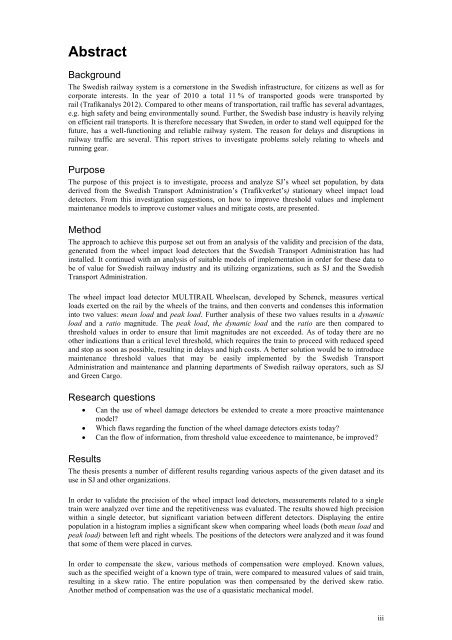Beslutsstöd för underhåll av järnvägsfordon - Chalmers tekniska ...
Beslutsstöd för underhåll av järnvägsfordon - Chalmers tekniska ...
Beslutsstöd för underhåll av järnvägsfordon - Chalmers tekniska ...
You also want an ePaper? Increase the reach of your titles
YUMPU automatically turns print PDFs into web optimized ePapers that Google loves.
Abstract<br />
Background<br />
The Swedish railway system is a cornerstone in the Swedish infrastructure, for citizens as well as for<br />
corporate interests. In the year of 2010 a total 11 % of transported goods were transported by<br />
rail (Trafikanalys 2012). Compared to other means of transportation, rail traffic has several advantages,<br />
e.g. high safety and being environmentally sound. Further, the Swedish base industry is he<strong>av</strong>ily relying<br />
on efficient rail transports. It is therefore necessary that Sweden, in order to stand well equipped for the<br />
future, has a well-functioning and reliable railway system. The reason for delays and disruptions in<br />
railway traffic are several. This report strives to investigate problems solely relating to wheels and<br />
running gear.<br />
Purpose<br />
The purpose of this project is to investigate, process and analyze SJ’s wheel set population, by data<br />
derived from the Swedish Transport Administration’s (Trafikverket’s) stationary wheel impact load<br />
detectors. From this investigation suggestions, on how to improve threshold values and implement<br />
maintenance models to improve customer values and mitigate costs, are presented.<br />
Method<br />
The approach to achieve this purpose set out from an analysis of the validity and precision of the data,<br />
generated from the wheel impact load detectors that the Swedish Transport Administration has had<br />
installed. It continued with an analysis of suitable models of implementation in order for these data to<br />
be of value for Swedish railway industry and its utilizing organizations, such as SJ and the Swedish<br />
Transport Administration.<br />
The wheel impact load detector MULTIRAIL Wheelscan, developed by Schenck, measures vertical<br />
loads exerted on the rail by the wheels of the trains, and then converts and condenses this information<br />
into two values: mean load and peak load. Further analysis of these two values results in a dynamic<br />
load and a ratio magnitude. The peak load, the dynamic load and the ratio are then compared to<br />
threshold values in order to ensure that limit magnitudes are not exceeded. As of today there are no<br />
other indications than a critical level threshold, which requires the train to proceed with reduced speed<br />
and stop as soon as possible, resulting in delays and high costs. A better solution would be to introduce<br />
maintenance threshold values that may be easily implemented by the Swedish Transport<br />
Administration and maintenance and planning departments of Swedish railway operators, such as SJ<br />
and Green Cargo.<br />
Research questions<br />
Can the use of wheel damage detectors be extended to create a more proactive maintenance<br />
model?<br />
Which flaws regarding the function of the wheel damage detectors exists today?<br />
Can the flow of information, from threshold value exceedence to maintenance, be improved?<br />
Results<br />
The thesis presents a number of different results regarding various aspects of the given dataset and its<br />
use in SJ and other organizations.<br />
In order to validate the precision of the wheel impact load detectors, measurements related to a single<br />
train were analyzed over time and the repetitiveness was evaluated. The results showed high precision<br />
within a single detector, but significant variation between different detectors. Displaying the entire<br />
population in a histogram implies a significant skew when comparing wheel loads (both mean load and<br />
peak load) between left and right wheels. The positions of the detectors were analyzed and it was found<br />
that some of them were placed in curves.<br />
In order to compensate the skew, various methods of compensation were employed. Known values,<br />
such as the specified weight of a known type of train, were compared to measured values of said train,<br />
resulting in a skew ratio. The entire population was then compensated by the derived skew ratio.<br />
Another method of compensation was the use of a quasistatic mechanical model.<br />
iii
















